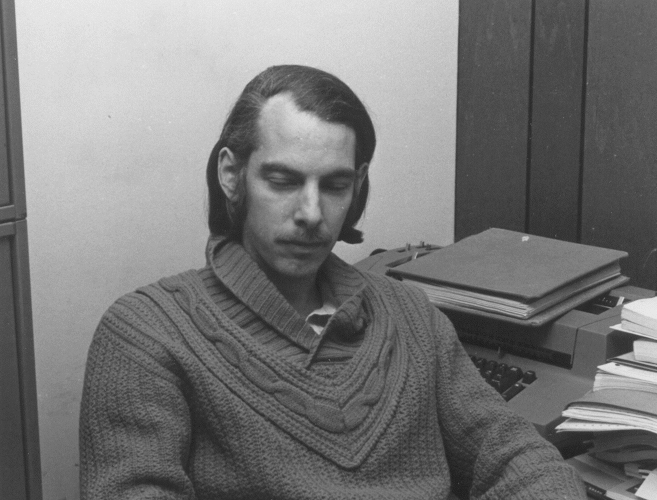GEOFFREY G. DOUGLASS
 Geoffrey G. Douglass arrived at the Naval Observatory from Case Institute of
Technology (Cleveland, Ohio) on April 28, 1967 to become a member of the
Astronomy & Astrophysics Department. His first project was to do literature
searches and editorial work on the UBV Photoelectric Catalog (PECAT, 1968). He
became proficient in filling in broken zeroes with an ink pen on camera
"ready" proofs from the IBM printer.
Geoffrey G. Douglass arrived at the Naval Observatory from Case Institute of
Technology (Cleveland, Ohio) on April 28, 1967 to become a member of the
Astronomy & Astrophysics Department. His first project was to do literature
searches and editorial work on the UBV Photoelectric Catalog (PECAT, 1968). He
became proficient in filling in broken zeroes with an ink pen on camera
"ready" proofs from the IBM printer.
He also participated in the major A&A projects: Parallax plate measuring on
SAMM, observing photographic double stars on the 26-inch refractor and measuring
those plates on the MANN two-screw machine. He was also responsible for training
and supervising all SAMM and MANN users.
He began working with C.E. Worley on the visual double star program and the
Double Star Catalog in 1968 and continued that collaboration until Charles's
death in December, 1997. He was responsible for all software development for the
Double Star Catalog, assisting in literature searches, additions and corrections
to the Catalog, and sending yearly updates to the two other repositories of
double star data. This entailed running more than 180 trays of IBM cards through
an erratic card reader (approximately one-half million cards once every year).
He assisted Worley in all aspects of producing the major revision of the Double
Star catalog, the Washington Double Star Catalog (WDS) in 1984. With the
acquisition of the speckle interferometer in 1990 for use on the 26-inch
refractor he became responsible for observing and reducing all speckle data
under the direction of Worley. A large part of his time in 1998 until his
retirement at the end of that year was devoted
to preparing the speckle data (>10,000 observations) for publication. It is
gratifying for him to see that the double star programs have taken their
rightful place as major projects at the USNO and in DoD, and that their
importance to fundamental astronomy has finally been realized.
He began to work on the Southern Astrograph Project in 1971 (later to become the
Twin Astrograph project (TAC)). Initially this project was to photograph the
entire southern hemisphere from a site in Perth, Australia. He was responsible
for testing of both sets of telescope lenses, and taking of all test fields and
selected area plates. When it became evident that the telescope could not be
sent to the southern hemisphere due to budget cutbacks, the telescope was used
to obtain plates for the Zodiacal Zone Catalog, and then the northern hemisphere
($-$18 degrees to +90 degrees in declination) from the USNO Washington site. He
was appointed manager of the Zodiacal Zone Project (1977), and then TAC Project
(1978-1985). Duties for the Zodiacal Zone Project entailed coordinating the
transfer and measuring of Yale Zone Catalog plates on the STARSCAN measuring
machine, and the observing of the Zodiacal Zone fields on the Twin Astrographic
Telescope. Duties for the TAC project were primarily to oversee and participate
in the observing of the northern fields on the Twin Astrograph Telescope. He was
also responsible for organization and coordination of transfer of the telescope
to New Zealand and for input on design of TAC facilities. He was honored to be
sent to New Zealand with the Twin Astrograph Telescope to begin the southern
observing project (1985-1988). While the project was not done due to the delayed
acquisition of a new red lens, observations of radio reference frame areas were
taken, and occultation data was also supplied to the two major New Zealand
national observatories. Upon his return to USNO Washington he oversaw astrograph
plate measuring on STARSCAN of the northern hemisphere plates by contract
measurers, and was responsible for testing of STARSCAN.
(Prepared by Geoff Douglass at the time of his retirement.)
 Geoffrey G. Douglass arrived at the Naval Observatory from Case Institute of
Technology (Cleveland, Ohio) on April 28, 1967 to become a member of the
Astronomy & Astrophysics Department. His first project was to do literature
searches and editorial work on the UBV Photoelectric Catalog (PECAT, 1968). He
became proficient in filling in broken zeroes with an ink pen on camera
"ready" proofs from the IBM printer.
Geoffrey G. Douglass arrived at the Naval Observatory from Case Institute of
Technology (Cleveland, Ohio) on April 28, 1967 to become a member of the
Astronomy & Astrophysics Department. His first project was to do literature
searches and editorial work on the UBV Photoelectric Catalog (PECAT, 1968). He
became proficient in filling in broken zeroes with an ink pen on camera
"ready" proofs from the IBM printer.